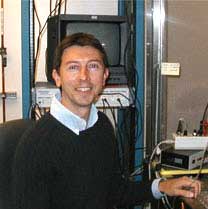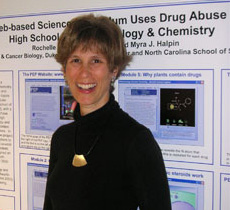Society for Neuroscience Honors Dr. Antonello Bonci's Research
 Dr. Antonello Bonci
Dr. Antonello BonciDr. Antonello Bonci, a neurologist and electrophysiologist at the University of California, San Francisco, and the Ernest Gallo Clinic and Research Center, received the 2004 Jacob P. Waletzky Memorial Award for Innovative Research in Drug Abuse and Alcoholism. The award was presented at NIDA's "Frontiers in Addiction Research" symposium, October 22, 2004, in San Diego at the annual conference of the Society for Neuroscience.
The $25,000 award recognizes a young scientist for outstanding work that furthers understanding of the effects of substance abuse on the brain and nervous system. Dr. Bonci's work focuses on the long-term changes in brain cells that underlie addictive behaviors. In the Frontiers symposium keynote presentation, Dr. Bonci described his research on cocaine-induced alterations in the ventral tegmental area (VTA). He also highlighted his laboratory's more recent investigations of the VTA's role in stress-related behaviors and presented findings on brain cells in the nucleus accumbens, another region critical in drug abuse.
"Twenty years ago, many would not have believed that such a prestigious honor would recognize drug abuse research. The Waletzky Award indicates the incredible growth of addiction research, which is now a pillar of neuroscience," said Dr. Eric J. Nestler, chairman of the Selecting Committee and a Society Councilor, who presented the award. The 2004 Frontiers symposium program featured 20 presenters and more than 70 posters, attracting about 600 participants.
Dr. Rochelle Schwartz-Bloom Is Recognized for Science Education Contributions
 Dr. Rochelle Schwartz-Bloom
Dr. Rochelle Schwartz-BloomAlso at the Society's annual conference, Dr. Rochelle Schwartz-Bloom of Duke University in Durham, North Carolina, received the $5000 annual Science Educator Award, which is presented to an outstanding neuroscientist who has educated the public about the brain and nervous system. Dr. Schwartz-Bloom developed curriculum modules that help high school students learn the biology and chemistry underlying addiction, drug testing, and nerve gas (see "Learning the Science of Drugs Helps Teens Master Biology, Chemistry"). She also developed a series of instructional materials that teach and reinforce several basic biology and chemistry concepts using examples from topics that fascinate young people—drugs and addiction.
High school teachers integrate the four modules into the standard science curriculum but can tailor the material to meet particular classroom needs. Students who learned the standard high school science content—including molecular structure, cellular structure, anatomy, physiology, and enzyme action—in the context of drug-related topics have scored higher on tests than those whose science classes did not include the modules.
"The curriculum is very innovative and worthy of recognition. It's founded on the idea that teenagers learn more if they think the course offers information that is relevant to their lives," says Dr. Cathrine Sasek, NIDA's science education coordinator. With funding from NIDA, Dr. Schwartz-Bloom is expanding the curriculum and developing Web-based and teacher training so more students and teachers can benefit.
